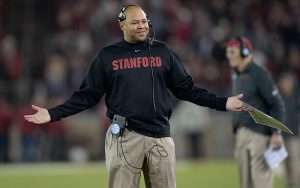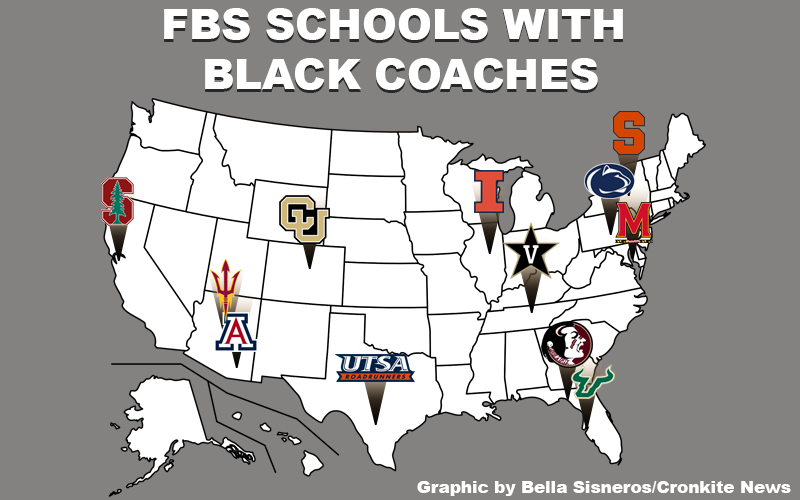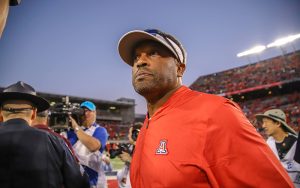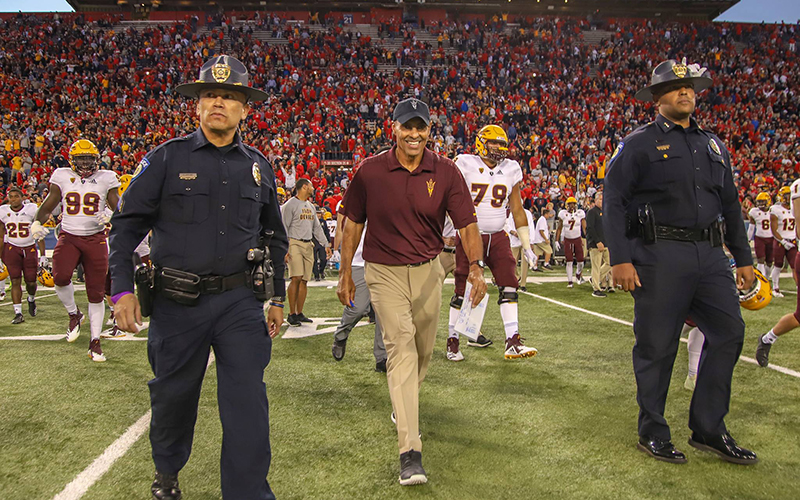PHOENIX – Sports have long been a vehicle for social protest, from U.S. Olympians Tommie Smith and John Carlos raising black-gloved fists at the Mexico City Games to quarterback Colin Kaepernick taking a knee during the national anthem to protest police brutality. Although some argue that athletes should stick to sports — or as a conservative talk show host said in February, just “shut up and dribble” — many players, including those in college, disagree.

Stanford coach David Shaw believes his most important role as a coach is not so much to preach but to “do the right thing and be those examples to help young people see what it takes to be successful.” (Photo by Thearon W. Henderson/Getty Images)
The issue has presented a unique challenge for African-American college coaches because many of the topics feature race as a key discussion point. How do they use their own history to help navigate the waters of debate for these young players — the majority of whom are black — while reconciling issues of athlete growth, future marketing concerns and public backlash?
“If you want to use (your) platform to point out an injustice, great,” Stanford coach David Shaw said. “The thing I tell our guys, be informed of what you’re talking about and be right. … If (they’re) legitimately trying to help somebody then they should feel empowered to do so.”
Stanford is a member of the Pac-12 Conference, which has the largest percentage of African-American head coaches in college football. When Colorado hired Georgia defensive coordinator Mel Tucker on Dec. 5, he joined Shaw, Arizona’s Kevin Sumlin and Arizona State’s Herm Edwards. Thirty-three percent — four of 12 — of the conference coaches are black, compared to 9.2 percent (12 out of 130) in the NCAA’s FBS.
Adding complexity to the issue, 55.9 percent of athletes in Division I football at the FBS level during the 2017 year were African-American, according to a 2017 study by the Institute for Diversity and Ethics in Sport.
Protests have become increasingly commonplace in professional sports. Many NFL players wore “I can’t breathe” shirts during the 2014 season to protest a grand jury ruling not to indict a police officer in the death of a New York man. And Malcolm Jenkins of the Philadelphia Eagles conducted an interview with scripted posters at his locker in June that called for criminal justice reform.
The protests prompted strong reactions from many, including media personality Laura Ingraham, whose “shut up and dribble” comments were aimed at the NBA’s LeBron James after he criticized President Donald Trump.

Black coaches make up just 9 percent of head coaches in the FBS, according to data taken from Sports Highlights USA. (Graphic by Bella Sisneros/Cronkite News)
Collegiate challenge
The conversations often take on a different tone at the collegiate level, however. Fewer athletes are as outspoken as their professional counterparts because of what is at stake.
When Missouri players threatened to boycott a football game in 2015 because of frustration with administrators they believed hadn’t done enough to combat racism on campus, backlash was significant.
“The stakes are so much higher for everybody involved than in the NFL,” author Dave Zirin told USA Today, “which means it encompasses a lot more risk and it also means that platform is going to be policed so much harder because these guys don’t have a union that can support them.”
Edwards and Shaw say they encourage their athletes to find issues that they’re passionate about but also emphasize that if they’re going to be committed, they have to be informed.
“Make sure you have knowledge before you speak,” Edwards said. “Don’t just speak off your emotions. Make sure you research whatever you’re passionate about and understand the depth of it.”
Without that, Edwards believes that people, and in particular athletes, aren’t taken as seriously and just become voices “speaking loudly and not making too much sense.”
“The platform that professional athletes, student athletes, and coaches have is a great platform,” Shaw said, “but for me it’s not necessarily a platform to preach as much as it is a platform to do the right thing and be those examples to help young people see what it takes to be successful.”
That’s one of the reasons Stanford and Arizona State brought in Brenda Tracy, who works closely with the NCAA on issues involving violence toward women and talks at length to players about consent. Shaw was inspired by her domestic violence seminar, “Set the Expectation,” and has used that mantra when talking to his team.
“The biggest thing we talk about in sports, which relates to life, (is) it’s not what happens to you, it’s how you react to it,” he said. “The idea is to set the expectation of how you’re going to handle success, failure, good things, bad things, and when those things happen you’ve already decided who you’re going to be.”
Taking out the guess work in those moments highlights what Shaw calls the difference between being reactionary and making a situation worse, and standing by your values in a way that helps.
Sumlin believes that a large part of being a college football player isn’t so much about the performance on the field as it is the maturation off it. He added that the diversity inside locker rooms helps his players navigate difficult topics.
“I think it’s part of the educational process for young men. You’re going to feel a lot of different things in your life,” Sumlin said. “Being able to have those open discussions and the exposure to all kinds of different values become important.”
Lacking diversity
These coaches acknowledge they feel the weight of responsibility to guide athletes properly because their remain so few black coaches in the upper ranks.
The University of Arizona is Sumlin’s third stop as an FBS head coach. He also coached at Houston and Texas A&M and recalls his introductions always included his role as the first, or one of the first, African-American head coaches at the school.

Arizona coach Kevin Sumlin believes diversity inside college locker rooms helps his players navigate difficult topics. (Photo courtesy Brady Klain/Walter Cronkite Sports Network)
“The more you want to be an example for the other people that look like you, the goal is over time that won’t be the first or second sentence that comes out at the opening press conference,” he said. “That’s how you know you’ve made real progress.”
The coaches have different perspectives on how to increase the amount of black head coaches.
“Sports is a reflection of our society. When you see men of color that become coaches, assistant coaches, quarterbacks, it becomes normal.” Edwards said. “Are we still a little bit behind times as far as the practices of hiring and opportunity? Yeah. But sports is a great way of creating that atmosphere (of diversity).”
Edwards has seen the progress that has happened since his playing days in the 1970s and ‘80s, and as his coaching career progressed in the NFL, he and the staffs he was on made it a priority to help ensure that the progress continued.
“My job with Tony (Dungy) when I was an assistant head coach in Tampa was to get the resumes of these guys,” Edwards said. “We’d hire two guys but we wanted to make sure one was a minority to give them an opportunity. He had to earn by his resume but that’s how we got the pipeline started.”
Edwards realizes that opportunity breeds progress and credits the mindset of his NFL coaching peers with instilling that philosophy in him.
For Shaw, it’s about having a deep pool of options.
“There are so many opportunities for young people to grow and have the opportunity to meet decision-makers,” Shaw said. “What we can’t ever do is say, ‘We just need to hire more African American coaches.’ What we need to do is have the biggest pool we can of viable candidates.”
Shaw feels that despite the numbers, the NCAA has a good hiring system and those driving the hiring process are free to choose who they want.
“The decision-makers, they’re trying to keep their jobs also,” Shaw said. “They need to be able to pick the person that’s best for them, so I don’t believe in quotas. I don’t believe in trying to up the percentages.”
What these coaches do believe in, however, is helping their young players navigate a landscape where sports and society intersect.
Sign up for CRONKITE DAILY to catch up on the latest news.
